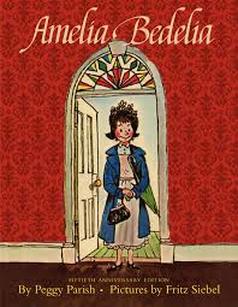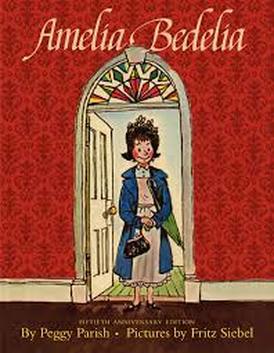This term we are going to be reading stories and poems that use words in interesting and fun ways. We are going to be learning about Spoonerisms, Neologisms and Puns. If you click on each of these words you will learn a little more about what they are and you will find some examples of them too.
A little bit of history . . .
Before reading today's text we will learn a little about the history of the Amelia Bedelia stories.
|
When Amelia Bedelia was first published in 1963, Peggy Parish was teaching the third grade in New York City. “Oh, Miss Parish,” one of her students exclaimed, “you’re not doing a thing but writing about yourself!” Peggy admitted that even she found similarities between herself and her famous creation. “I guess that loving mischief as much as Amelia Bedelia and I do shows. I simply enjoy laughing at life.” More than forty years and twenty-one million Amelia Bedelia books later, the literal-minded housekeeper is still going strong. |
Peggy went on to write many Amelia Bedelia stories and other books.
After living in New York for many years, Peggy Parish returned to her native South Carolina. She died in November 1988, but Amelia Bedelia lived on. Fan letters flowed in,and many readers asked when the next book would be out. In 1995, demand for more adventures prompted Peggy’s nephew, Herman Parish, to continue the series. He has just finished his fifteenth Amelia Bedelia book. Herman visits schools across the country,
Herman Parish was in the fourth grade when his aunt, Peggy Parish, wrote the first book about Amelia Bedelia. The lovable, literal-minded housekeeper has been a member of the Parish family ever since. Peggy would be proud and delighted to know that her nephew is carrying on—for a new generation of readers—the tradition she began years ago.
After living in New York for many years, Peggy Parish returned to her native South Carolina. She died in November 1988, but Amelia Bedelia lived on. Fan letters flowed in,and many readers asked when the next book would be out. In 1995, demand for more adventures prompted Peggy’s nephew, Herman Parish, to continue the series. He has just finished his fifteenth Amelia Bedelia book. Herman visits schools across the country,
Herman Parish was in the fourth grade when his aunt, Peggy Parish, wrote the first book about Amelia Bedelia. The lovable, literal-minded housekeeper has been a member of the Parish family ever since. Peggy would be proud and delighted to know that her nephew is carrying on—for a new generation of readers—the tradition she began years ago.
A note before you read . . .
|
As you will discover, it is Peggy's love of words and their meanings that make these books so interesting. Peggy uses words that have more than one meaning to add humour to the story and also to make the character of Amelia so loveable.
She also uses idioms, which are funny sayings that could be interpreted wrongly if you didn't understand them, to create hilarious situations in the story. So this wordplay is very like using puns to create humour. They are "Mix-ups with vocabulary." |
Reading Amelia Bedelia
Today we are going to read the very first Amelia Bedelia book that started the series over 50 years ago!
|



